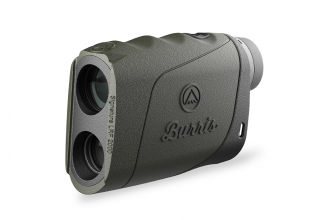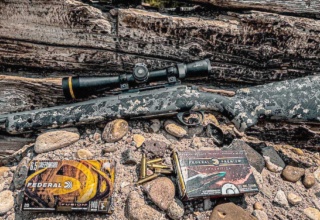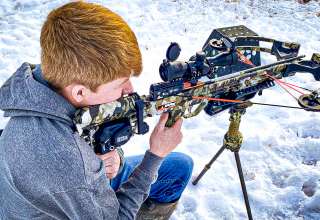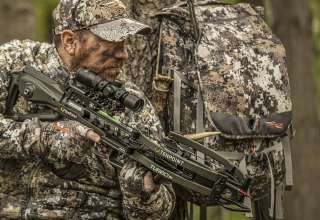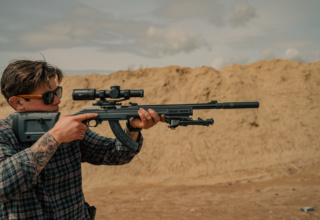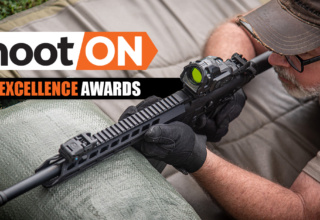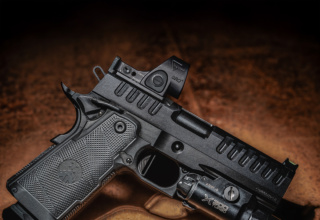Advances in archery gear have extended the range of the bowhunter’s accuracy potential. Are you ready for the challenge?
by Jace Bauserman
Yes, today’s bow-and-arrow combinations are capable of incredible accuracy at extended distances. A quality movable sight (single-pin or multi-pin) paired with a drop-away (limb-driven or cable-driven) rest and a stabilizer system with customized weight and length will deliver shafts into the 10-ring at distances of 100 yards and beyond. I love it and I hate it all at the same time.
Archery is a close-range game. Period. While I practice regularly at ranges of 80, 90, and 100 yards, it’s important to note these practice sessions are designed to make me more proficient at distances between 20 and 60 yards. The problem is, too many archers are purchasing a new flagship bow, outfitting it with the best accessories, slapping a sight tape on it, and sending carbon long distances through the air. This is a recipe for long- and short-range frustration.
Know Thy Equipment
Regardless of what bow, arrow, and accessory package you choose, you must get familiar with your system. I spend weeks each year shooting throngs of arrows at 20, 30 and 40 yards. Why? Confidence. Shooting too far too soon can create anxiety, which leads to target panic, which leads to accuracy issues—not to mention you’ll be losing pricey arrows. Shooting at close range and developing a repeatable shot sequence that includes proper grip, a smooth draw, consistent anchor, and a shot execution that allows the release to fire the bow is crucial. This system is also critical to creating a proper sight tape, which you will need if you plan to shoot distance. More on this later.
When you can consistently put arrow after arrow where you want it on a spot as well as on a 3-D target at 20, 30 and 40 yards, you can start backing up. My rule of thumb for spot shooting is hitting a golf-ball-sized spot at 20, a baseball-sized spot at 30 and a softball-sized spot at 40. When you can do this and remain relaxed and let your release fire the bow, you can start moving back.
Extended Range Shooting
I consider extended-range shooting to be any shot beyond 60 yards. Even when hunting out West, where shots tend to be a bit longer, I always try to get within 60 yards of my target animal. Too many bad things can happen if you take shots longer than 60. Have I? Yes. I don’t want to give you false information and pretended to be something I’m not. I use my years of in-the-field judgement to make a decision on whether or not a past-60-yard shot is ethical. The body position and posture of the animal are two key factors. I also weigh my shooting ability as well wind speed into the equation.
When practicing at long range, it is paramount you remember that the shot you make at 20 yards is the same shot you make at 80 yards. I see too many shooters backup to a longer distance and totally change their routine and form. Don’t do this. Everything remains the same. Don’t focus on trying to hold your pin dead still on a spot. The best archer in the world can’t get 100-percent steady on a dot. Let your pin float. Your subconscious mind is constantly dragging that pin back-and-forth across the spot you want the arrow to impact. Your focus is on aiming, relaxing and letting the release fire the bow. I like a 3-D target when shooting distance. Spots, especially at long ranges, can increase shooting anxiety.
Extra Tips for Shooting Distance
I’m not a super-short axle-to-axle bow fan, but that doesn’t mean you can’t shoot distance with a bow that only has 28- to 30-inches between the axles. I just prefer a rig between 31 and 35 inches. For me, a longer bow means a steadier platform.
A big key to long-distance stability is stabilizer weight and length. I recommend a front- and back-bar system. A stubby six-inch stabilizer will do absolutely nothing for you when shooting extended distances. Stabilizer manufacturers have done a great job at providing stabilizers of different weights and lengths and you need to experiment. Once you find front- and back-bar lengths that work for you, start playing with weight. Add weight to the front and back. Take a weight off the back and add it to the front and vice versa. This process may take days, but it’s paramount. Do not stop until you find a weight and length that give you the warm fuzzies.
Also, do not get in a hurry when it comes to your sight tape. Most of today’s movable sights come with tapes, and you can build your own at places like Archers Advantage. While I’ve had success with both, my favorite method is a blank tape and fine-tip Sharpie. Even if you’ve punched all your data into Archers Advantage and have the perfect tape, don’t force it. If you’re dialed into 80 yards and you’re hitting an inch low, try another tape. Archers Advantage will provide you with a range of tapes to select from and you can try another. If that doesn’t work, use a blank tape and a Sharpie.
Arrow choice is another critical part of the long-range game. A shaft with more surface area provides the wind more to press against in flight. I prefer a smaller diameter shaft when shooting distance. In addition, weight is also important. A shaft that is too light will be affected more by the wind. Again, finding the right arrow comes down to tinkering and testing. Two of my favorites are Easton’s HyperSpeed Pro and 5MM Axis.
Practice often at long ranges. Nothing builds confidence like delivering two-inch groups at 80 yards and beyond. With that noted, if your groups begin to widen or you find yourself punching the trigger or anticipating the release of your hinge, STOP! Move up to 20 yards and start shooting.
Lastly, enter some 3-D shoots. Sure, you can drive tacks from 70 in your backyard, but can you do it while other archers are watching? While nothing can simulate sending an arrow toward a breathing animal, 3-D shoots do help. If you’re wanting to take some long-range shots under pressure, I recommend one of the many Total Archery Challenge events that are held around the country.










